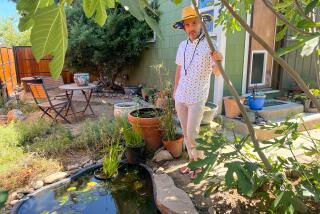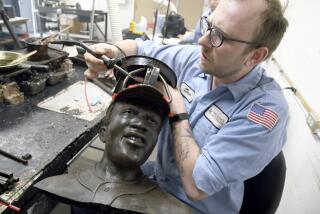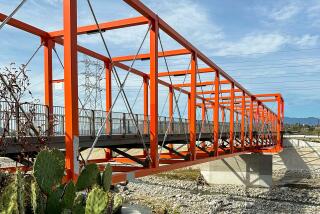TRAVELING IN STYLE : SPLASH! : With Hundreds of Cascades and Pools, Kansas City is Quite Possibly the Fountain Capital of the World
KANSAS CITY CALLS ITSELF THE CITY OF FOUNTAINS. It’s claimed that we have more of them than Seville, our Spanish sister city, itself pretty famous in the fountain department. We supposedly have more fountains even than Rome--more working ones, at least.
Just how many fountains is that? Nobody seems to know exactly--not even the City of Fountains Foundation, established to spread the good news about our wealth of decorative public plumbing. The number certainly is in the range of several hundred, counting public fountains, those in commercial buildings and unenumerated others burbling and splashing in private gardens and inside posh homes.
Why so many fountains here, in this Missourian metropolis in the very middle of America? There’s no dependable explanation. A reasonable guess might be that early real estate developers and community leaders conceived of fountains as a kind of image builder; the genteel plashing of water on European-style statuary, that is, might help discourage that stubborn first impression so many visitors seemed to have of the city as a graceless, rough-handed outpost at the prairie’s edge. On the other hand, maybe we have so many fountains simply because, in a river town whose greatest remembered calamities have been floods, it seemed natural to install examples of water in motion on the heroic scale.
Kansas City isn’t very old. The first trading post at this spot on a bend in the Missouri River wasn’t built until 1821, and the city was incorporated only in 1850. In Kansas City’s early days, the wind, quartering in from the packing plants and the hog and cattle pens down at the stockyards, was yeasty with the perfume of an industry that caused us to be called quite a few other things before we were called the City of Fountains. In fact, local historians have recorded that some of our earliest steps toward this latter distinction came in the form of ornate troughs built by the Humane Society for the use of the town’s horses.
I’ve spent my whole life in Kansas City, but it never occurred to me, as a boy, that I might be growing up in the fountain capital of the planet. Ours was a neighborhood of modest bungalows occupied by hard-working and practical folks. Never mind decoration. We were grateful to get cinders spread on our street when it snowed. Today, of course, the horses, the meatpackers and the stockyards are gone, and so is my old neighborhood--part of it gone to ruin (or to drug houses), the rest bulldozed for a freeway planned 30 years ago but only just now being built. And, having more or less grown up in the meantime and moved to the other side of town, I’ve started appreciating our wealth of fountains at last.
The first fountain I remember was attached to an unpaved reflecting pool along one of the city’s many boulevards. The fountain itself wasn’t much, but the pool contained a miraculous prosperity of bullhead catfish. My parents would take me there in the evening. We would unload from the trunk of the old Pontiac our worm cans, jointed cane poles and folding canvas camp stools and, businesslike, set about filling up our fish bucket. Residents of the big houses nearby must have been aghast at that spectacle of proletarian resourcefulness. To them, the pool was something to be strolled around with pedigreed dogs on leashes or something upon which enormous hand-built scale models of clipper ships should be sailed. Then, out of nowhere, this family of Joads would appear, seeking catfish. Nobody spoke to us. Probably they pretended not to see us. We didn’t care. It was just at the end of the Great Depression, an event that lasted longer on some streets than on others. And protein, by heaven, was protein! One great Kansas City fountain-building pioneer was developer J.C. Nichols. In 1922, charmed by a visit to Spain, he began constructing a Moorish-influenced retail and residential district called the Plaza--sometimes described as America’s first shopping center and certainly one of its most elegant. No fewer than 40 of the city’s fountains may be found in and around the Plaza today--among them the monumental J.C. Nichols Memorial Fountain, sculpted in Paris in 1910 by Henri Greber; the Fountain of Bacchus (complete with nymphs and satyrs), cast in bronze in 1911 and brought here from Worcestershire, England; the Mermaid Pool, inlaid with ceramic tile and adorned with three voluptuous Carrara marble figures dating from about 1680, and an untitled abstract bronze sculpture-fountain, installed in 1971 by architect Robert Berkebile and artist Norman Brunelli. At the Ritz-Carlton Hotel, adjacent to the Plaza, a recirculating sheet of water more than 50 feet wide cascades over a curved lip and falls 17 feet from the hotel’s facade to the level of the boulevard below. (Elsewhere in the complex are such non-aqueous works as a reproduction of Seville’s famed Giralda Tower and a nearly life-sized sculptural rendering of Da Vinci’s “The Last Supper.”)
One of the smallest fountains in the Plaza, a durable favorite, is the Boy and Frog, a piece from the Romanelli Studios in Florence, acquired in 1929. It depicts a bronze nude toddler standing in a marble basin with a bronze frog perched on its rim. The frog is squirting a fine stream of water that strikes the child in his mid-parts. The good humor of the tableau is charming to the adult eye. But years ago, for an uncivil youth and his chums from across town venturing as aliens onto that upscale turf, Boy and Frog was the stuff of embarrassed japes and sniggers, having to do with the question of who was squirting whom, and exactly how.
Not far from the Plaza are a memorial fountain honoring Kansas City’s Vietnam veterans and another saluting the nation’s Eagle Scouts. (The Kansas City area council of the Boy Scouts of America consistently awards more Eagle Scout badges than any other council in the country). Elsewhere in the city are fountains dedicated to local firefighters killed in the line of duty, to “The Spirit of Freedom,” in recognition of contributions to civic life by Kansas City’s black community, and to “The Muse of the Missouri.”
One of the handsomest of our fountains, and surely the most controversial, adorns the center of a traffic circle where two graceful boulevards intersect. In its midst, three winged horses surround a marble pedestal supporting an elevated stone bowl in the center of a pool 100 feet in diameter. The aesthetic value of the fountain is not at issue; public safety is. The speed limit on the larger of the two boulevards, Ward Parkway, is 35 m.p.h. At this velocity, anyone with enough coordination to tie his shoes should be able to negotiate the circle without adventure. Yet occasional failures make the news--and sometimes the obituary column. Calls have thus been heard to remove the fountain and straighten the boulevard. The counterargument is that cities ought not to be designed solely for the convenience of drunks and drag-racers. Better to put the offending drivers afoot or give them bumper cars. So far, the fountain’s defenders have prevailed.
More fountains: A five-story fountain-waterfall tumbles dramatically down the ledges of the limestone bluff that provides a striking interior backdrop to the lobby of the Westin Crown Center Hotel. There’s a complex of waterworks, too, at Royals Stadium: While many major-league baseball stadiums around the country celebrate home-team home runs with pyrotechnic displays, our own baseball team marks these infrequent events with leaping jets of colored water on the hillside in back of center field. (Since the Royals’ game is built around speed and a knack for artificial-turf singles, not sheer hitting power, we don’t use up much moisture this way.) Even our town’s newspaper, the Kansas City Star, has a fountain on its front lawn--and since the paper’s offices have been declared smoke-free, some of us who toil there now devote more time to admiring the fountain than we spend at our computer terminals.
Along with fountain statuary, the tradition of tossing money into fountains seems to be something we’ve imported from Europe. I’ve always been mystified as to why people do this. A long time ago, I actually stood beside that fountain in Rome that was made famous by that motion picture. The bottom sparkled with change. People were hugging and kissing and having their pictures taken and throwing in money. In my 20s, empty of pocket, I started thinking about how it might be possible to get money out of the fountain. But police were everywhere--and anyway, the Italians were printing bank notes the size of supermarket tabloids back then, so the coins weren’t worth much anyway. (I read recently that this particular fountain now takes in almost $190,000 a year in lucky coinage.)
People in Kansas City, and probably in Seville and Rome, too, work whole lifetimes and make it a point to stay out of jail in hopes of moving from some cracked-curb neighborhood to an area filled with fountains. What no one ever tells you is that getting there is a mixed blessing. Some years ago, my daughter, at about age 10, was having a sleep-over for a dozen or so of her friends. The living-room floor was a tangle of sleeping bags. The house was filled both with ungovernable energy and with a variety of sounds, human and recorded, that I’d never heard before. At midnight, we suggested that it might be time for these angels to retire. At 1 a.m., we told them that we were sure it was time. At 2 a.m., we threatened to start calling their parents to come over and collect their spawn.
The room below went silent as a crypt. And we, being fools, went to sleep. A telephone call in the hollow dark of morning woke us up. “You’re having a slumber party,” said a stranger’s voice. “Who’s this?” my wife demanded. It was 4 a.m. “The police. Some of your guests are swimming in a public fountain.”
“No, you’re mistaken. They’re all downstairs asleep.”
“Go look,” the officer said. “Then you might want to give us a call back.”
The fountain in question turned out to be a small one, with a shallow pool, set in a little scrap of greenery where two streets meet a mere two blocks from our house. I’d never noticed it before. When I got there, the truants were sitting on the pool’s rim in their wet nightclothes, shivering with the cold and with the enormity of their offense. “Will we have to go to jail?” one of them asked. They’d never been busted before. The uniforms and the glint of badges had put the fear in them, though the two patrolmen were laboring mightily not to laugh.
“What made you do it?” I asked them in the car afterward. “We just woke up and thought about it,” one replied. Some people throw their money in. Some people throw themselves. I guess there’s just no explaining the magic of running water.
GUIDEBOOK: A Fount of Information
Getting there: USAir flies nonstop from Los Angeles to Kansas City three times a day, Sunday through Friday, and twice a day on Saturdays. There are frequent connecting flights to Kansas City from Los Angeles on Delta Airlines, American Airlines and Southwest Airlines; from Ontario and Burbank on Delta, American and America West and from Long Beach on America West and American.
Where to stay: Adjacent to the Plaza are the Raphael Hotel, 325 Ward Parkway, (816) 756-3800, for reservations call (800) 821-5343, $85-$105 per night for two; the Ritz-Carlton, Wornall Road at Ward Parkway, (816) 756-1500, for reservations call (800) 241-3333, $129, and a bed and breakfast called Southmoreland on the Plaza, 116 E. 46th St., (816) 531-7979, $100-$135. One of the main downtown hotels is the Westin Crown Center, 1 Pershing Road, (816) 474-4400, for reservations call (800) 228-3000, $72-$129.
Fountain-watching: Brochures and maps giving suggested routes for walking and driving tours of the city’s fountains and other notable public art can be obtained from the Convention and Visitors Bureau of Greater Kansas City, City Center Square, 1100 Main St., Suite 2550, Kansas City, Mo. 64105, and from the City of Fountains Foundation, 106 W. 11th St., Suite 1121, Kansas City, Mo. 64105. A map and brochure for the Plaza exclusively is available from the Plaza Merchants Assn., 4625 Wornall Road, Kansas City, Mo. 64112.
More to Read
Sign up for The Wild
We’ll help you find the best places to hike, bike and run, as well as the perfect silent spots for meditation and yoga.
You may occasionally receive promotional content from the Los Angeles Times.






